#food prepper
Text
SHELF STABLE BUTTER...
To all the Preppers out there.... what are your experiences or tips to store butter? 🤔
#pay attention#educate yourselves#educate yourself#knowledge is power#reeducate yourself#reeducate yourselves#think about it#think for yourselves#think for yourself#do your homework#do some research#do your own research#ask yourself questions#question everything#preppers#butter#food hacks
160 notes
·
View notes
Text
#emergency preparedness#meat curing#preparedness#food storage#prepping#preppers#shtf#preparedness saturday#food preservation
37 notes
·
View notes
Text
Hob's relationship with food is a complicated one. He stands in the kitchen of the New Inn, because the big pots fit better on the stove down here than on the one upstairs. He has been hungry many times in his life, not just in the century following Eleanor's and Robyn's death. There were many occasions when food was sparse or straight up not available. Sometimes he thinks it has messed with his brain a bit.
Hob checks the temperature and hopes none of the jars have opened or spilled over. Twist-off is a marvelous invention, but for this he'd rather put his trust in metal clips and rubber. It feels safer. That's why he's doing this in the first place, even if it takes up much of his time in the summer and fall. It feels safe. It calms him.
The small backyard of the inn is crammed with raised garden beds, trellises put up along the wall and fences. In the beds against the brick wall are the tomatoes, because it absorbs and reflects the warmth of the sun. There's one bed full of straw and potatoes, one with beans, one with carrots, there's cabbage and salad and turnips and strawberries. In the corner grows a small, gnarly apple tree and next to it a single cucumber plant, taking over almost the entire floor space between the beds. Hob has tried and failed to tie it up along the trellis countless times, so he lets it be where it is happy and just carefully steps over it each time he comes to the garden, big leaves brushing his bare legs.
The raspberries along the fence are a right hassle to maintain, growing through to the other side to grab at the pedestrians for nutrients, Hob is sure. They're vicious. He keeps them anyway, because he is a sucker for preserved raspberries over porridge, especially in winter. It's easy to make a lot of it, too. He just picks the ripe ones, pops them into the freezer and preserves a large batch at the end of the season. Hob still remembers the early centuries of his immortality, when he could only eat berries whenever he came across them in the woods and that would be it.
He checks on the pressure canner next to the large pot with the tomatoes and takes the heat down a bit. Beans are tricky. He'd done them his usual way up until he'd got a nasty bout of botulism in the 60s. And while he's immortal, he's as partial to pain as the next bloke, which is not very. Well. Except in certain circumstances, none of which ideally involve beans. Or jars. He only ate store bought beans for two decades after that, until he saw an ad and purchased his first pressure canner and welcomed the tall, delicate plants back into his garden. Because despite the rising quality of preserves and cans in stores it never tastes quite the same, does it?
He's done his fair share of curing meat, too, ham and sausages and fish, way, way, back. Still remembers his mother teaching him, remembers her big, strong hands, smoke burning in his eyes. This winter he plans on getting back into it, reading a few books, maybe taking a course. A bit less nitrite in his diet would do him good. Hob shakes his head. He sounds like his own grandmother would if he'd been born 35 years ago.
He's still working on refilling his stash. After the pandemic hit he'd slowly given most of it away, to students, to neighbors, to friends. Some of it he personally put on doorsteps, for the rest he'd organised a pick-up system with boxes. The walk-in pantry behind his kitchen had been almost empty. Sometimes he wonders if he would have liked more space in his kitchen, but then again the kitchen down here is also technically his. He wouldn't trade the calming reassurance of having food readily available to him, no matter the circumstances, for a bit of sitting space.
The next day, when the jars have cooled down, he carries them upstairs into his pantry, past the food-safe buckets full of grain and flour and sugar, past the empty crates where he will store his cabbages, his carrots and turnips in cool sand, his apples wrapped in newspaper come fall, and sorts the new jars behind the few remaining ones from last year. He figures after more than 600 years of living he's allowed to be a little crazy.
#I feel like Hob would be a bit of a prepper#going hungry for a long stretch of time HAS to have a certain effect on you#I know it certainly calms ME to have a bit of a food stash#the sandman#hob gadling#Hob headcannon#my fic
244 notes
·
View notes
Text



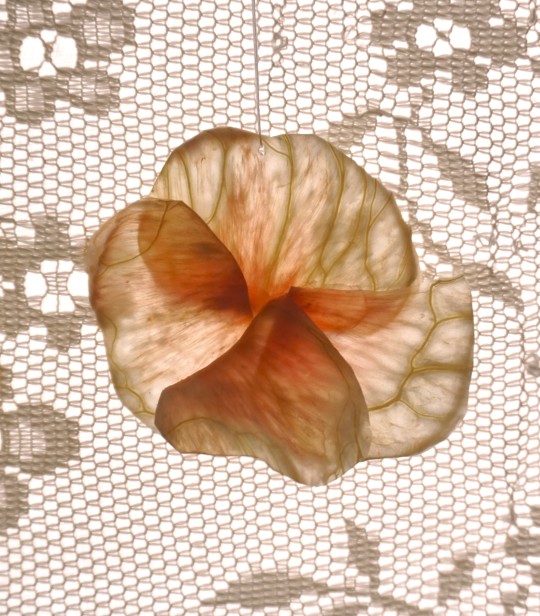



I thought that these inner sections of a pomelo peel thing kind of looked like flower petals with their coloring, so I left them out to dry for a few days, and then glued some of them together to make little "flowers" to hang in my window.
#crafts#I like the see-through ness of them and the color gradient. And pomelos are one of the foods to me that are very fun to disassemble#(like how I enjoy peeling carrots. or cutting cabbage. etc.) I don't actually eat citrus that much but some of the people I know#and live with do. so I'll always volunteer to cut stuff up or peel fruits if I'm over at someone's house or etc#I am.. the Food Prepper .. lol.. I could never be a chef due to the stress and the Hot of a kitchen and me being so heat sensitive#but in a broader sense I love doing little menial tasks like that. especially if there's some element of like 'try and get the sections all#cut as evenly and neatly as possible'.. sitting there like ..ouuu.. a challenge.. i will cut this onion into the thinnest slices known to#man.. this is now my quest and my destiny... etc. gjhbhj#ANYWAY... though I originally wanted to kind of sew them together with string so there wasn't glue visible or anything#I ended up having to glue them for them to hold their positions properly#So it looks weird because they're so trasnparent that you can kind of see the glue lines at some angles... but alas#still nice when the light shines through them
20 notes
·
View notes
Text

#survival#yearzerosurvival.com#preppers#survival blog#preppertalk#prepper blog#prepper#shtf#prepper network#yearzerosurvival#survival forum#survival preppers#off the grid#survival tips#survival foods#survival garden
107 notes
·
View notes
Text
Food For Thought
Do you have enough food stored to eat for two weeks if you lost power?
31 notes
·
View notes
Link

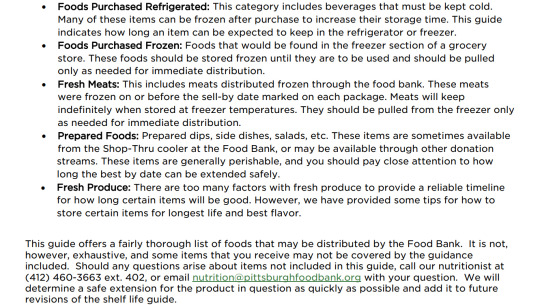







#shelf life foods#foods#shelf life of products#shelf life of foods#food bank#adulting#adulthood#reference#references#cooking references#charts#food references#food reference#how to be an adult#canned foods#food storage#homesteading#survival#preppers#pantry life#food pantry life#pantry food storage
67 notes
·
View notes
Text
11 notes
·
View notes
Text

Tactical Bacon
28 notes
·
View notes
Text

Homesteaders Handbook is a comprehensive guide that provides information, tips, and practical advice on various aspects of homesteading. It is designed to help individuals or families who are interested in starting or improving their homestead to lead a more self-sufficient and sustainable lifestyle.
I think every person should have this book in their home, next to their emergency foods or in their bug out bags. This knowledge is better at your fingertips now, as you might not be able to get it during crisis or blackouts. ask my anything.
#homesteading#survival tips#off grid#natural disasters#doomsday#preppers#meal prepping#grow food#chicken#farming#farmhouse#eggs#self reliance
5 notes
·
View notes
Text
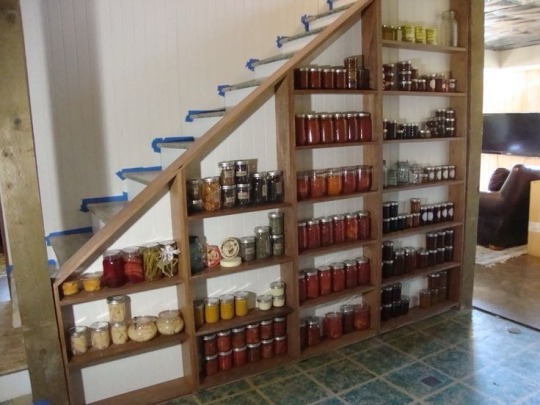
There is always some nook or cranny that can be used to store preps. Be creative.
38 notes
·
View notes
Text
*picks up Conservative, traditionalist female hobbies but in a feminist, antifascist, anticapitalist kinda way*
#the oracle hath spoken#sucks how for many of them i can't check out online spaces for experiences tips and resources#bc most of them fall under prepper- homesteading-activities so they're RIDDLED with fascists of all flavours#and adjacent weirdos i cannot tolerate ethically and politically#i just wanna become more sustainable and self-sufficient! but in a communal way#i'm way too comfortable and neurotic to like start fires and go foraging#so u know. gotta contribute to the post-revolutionary community somehow. without getting cold and wet#anyway mending clothes is punk and so is knitting and growing food#we only got three strawberries and one chili this year but those were very tasty!#i think the chili was tasty it was way too hot to tell but that means it was grown right right?#improvement!
69 notes
·
View notes
Text
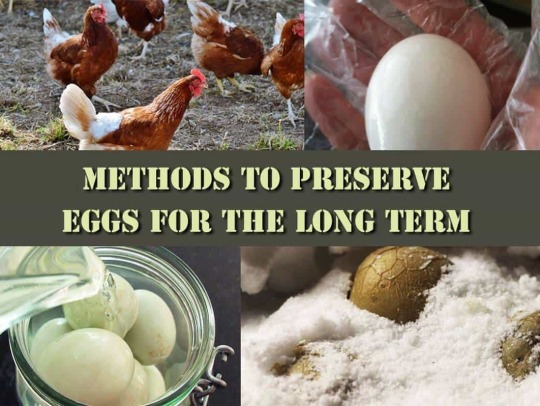
Preserving Eggs Long-Term:
As a new chicken owner (since May 2023), I recently discovered that I cannot eat all of the eggs my chickens are laying, even after those I sell or give away. Hence this post on preserving eggs long term. Even if you're not a chicken owner, sometimes it's good to buy [anything] in bulk to delay paying increased food prices. So, here goes with some ideas to preserve eggs up to a year. I will update this posting as I find new resources:
Freeze Dried: My favorite breakfast always includes eggs but, in a camping (or bug-out) situation, they can be heavy, space-consuming and create a potentially messy situation. Several commercial freeze-dried options are available but are costly. While a bit time-consuming, DIY Freeze-Dried Eggs can be a cheaper alternative.
Reference Link
Freezing Raw: Eggs should not be frozen in the shell, but can be out of the shell. Crack a single raw egg into each slot of an ice cube (or muffin tin) tray. Pre-scramble it or leave as is depending on your future use. Freeze in the tray, then pop out and put each egg in a zip-lock bag to keep frozen and free up the ice cube tray for another purpose. OR, just break an egg (or eggs) directly into the zip-lock bag then freeze. To use, simply leave each frozen egg sitting at room temp in a bowl to defrost. Freeze for up to 3 months or as long as 1 year.
Reference Link 1
Reference Link 2
Freezing Cooked: Freezing cooked eggs can be more difficult. The texture and quality of eggs can suffer if you're not careful. The best way to freeze cooked eggs is by folding them into other ingredients (recipes) that will hold up well in cold temps; the moisture from the ice formed when freezing certain egg dishes can actually help the eggs taste better when they're reheated.
Reference Link
Hard Boiled: Hard-boiled eggs, placed in vinegar/brine, can be preserved up to 3 months, if closed in an airtight "canning" jar, preferably made of glass or ceramic, not in metal. Refrigerated hard boiled eggs, still in the shell, will last about 1 week; unpeeled, about 3 days. Peeled or unpeeled, they will last only two hours at room temperature.
[Reference 1]
[Reference 2]
Fresh/Raw: Straight from the chicken or other bird (not the store), fresh eggs, unwashed and in the shell, can be preserved much longer than any other preservation method. Fresh, unwashed eggs will have a room temperature shelf-life of about 2 to 4 weeks while refrigerated eggs will last 3 to 6 months. Eggs that are preserved with a mineral oil coating can last from 6 months to 1 year. Eggs preserved with the water glassing method (pickling lime water) can last 1 to 2 years.
[Reference 4]
[Reference 5]
[Reference 6]
Egg Safety Tips: Always rinse eggs, under fresh warm running water, before use. Don't soak eggs except to hard boil. Wash hands, with soap and warm water, after handling eggs.
Related Links:
Preserve Fresh Eggs Without Refrigeration
Ways to Preserve Eggs (Safely)
Cook a Raw Egg in its Shell in Campfire Ashes
About Chickens and Eggs
[14-Point Emergency Preparedness Checklist]
[11-Cs Basic Emergency Kit]
[Learn to be More Self-Sufficient]
[The Ultimate Preparation]
[5six7 Menu]
This blog is partially funded by Affiliate Program Links and Private Donations. Thank you for your support.
#prepare4tomorrow#prepping#prepper#survival#diy#eggs freeze dried diy#egg preservation for long term food#food long term#eggs#eggs frozen
6 notes
·
View notes
Text


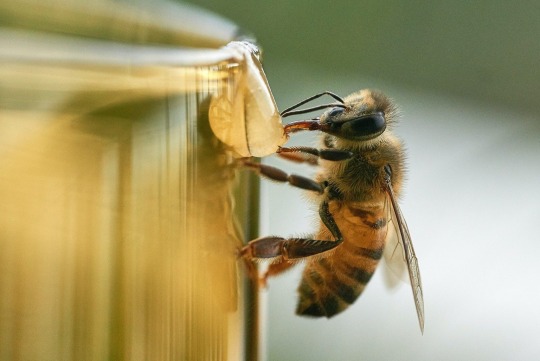
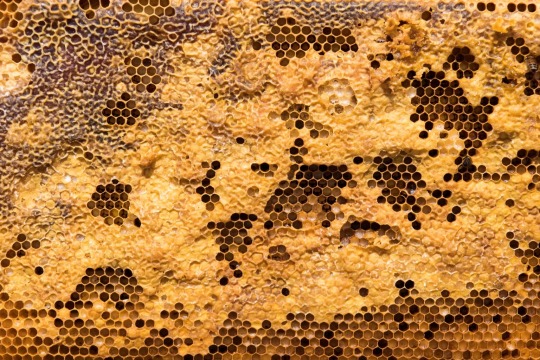
#survival#survival foods#superfood#yearzerosurvival.com#outdoors#survival blog#prepper blog#preppers#shtf#preppertalk#prepper network#prepper#bees#honey
10 notes
·
View notes
Text
Edible (and Non-edible) Plants & Flowers Throughout the United States [Part 1]

The following plants, flowers and mushrooms can be found throughout the United States, so identifying and harvesting, as well as being able to identify their edible parts, is undoubtedly priceless information in the event of a SHTF situation. You should discuss the safety of ingesting these plants and flowers if you are pregnant and/or breastfeeding.
Go to Part 2.
Acorns (Quercus)
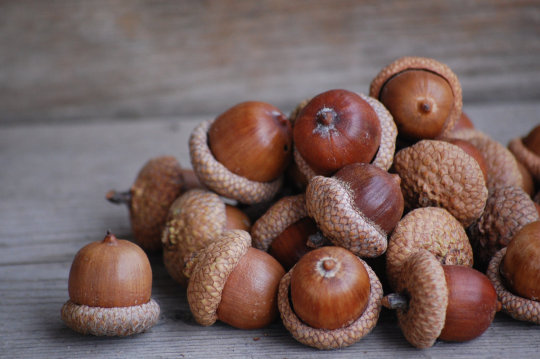
How to identify it: There are two basic types of acorn -- red acorns and white acorns; their color depends on the type of oak they come from. Acorns can generally be identified by their cups, shape, color, and size. Overall, acorns are ball-shaped or oval or some have ridges on them; and the woody cup of acorns can be hairy, scaly or smooth. Mature acorns are brown, black or red.
Where to find it: Acorns are the nuts of oak trees, and so naturally the best place to find acorns is in the drip-line of oak trees.
Edibility & flavor: Acorns taste bitter if they're not leached; however, when roasted, they have a sweetish, nutty flavor. Acorns must be boiled or soaked in water to remove the tannin, which will turn the water a brownish color. This water should be thrown out and replaced and the process repeated until the water no longer turns brown.
Benefits: Effectively controls blood sugar levels; rich in complex carbs, minerals & vitamins; lower fat content than other nuts; good source of fiber.
Caution: Acorns contain tannins, which can be toxic in large amounts and can prevent you from absorbing nutrients. Too much tannin has been linked to cancer and liver disease.
Burdock (Arctium lappa)
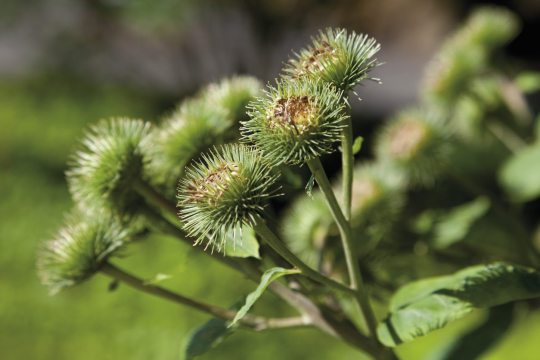
How to identify it: Has large, wavy-edged leaves that are light-colored, woolly on the underside and darker and smoother on the top side. Stalks can grow 4 to 5 feet; flowers are pink and purple with hooked bracts that can adhere to fur and clothes.
Where to find it: Found in pastures, fencelines, and disturbed areas with little competition from surrounding foliage.
Edibility & flavor: Peel the outer layer before eating; can be eaten raw or cooked. Raw burdock is earthy and kind of bittersweet like an artichoke.
Benefits: Contains tons of antioxidants, purifies the blood, may serve as an aphrodisiac, and can treat skin issues (such as acne and eczema).
Caution: Burdock can grow alongside and closely resemble belladonna nightshade, which is toxic. Burdock is also a natural diuretic, so don't ingest it if you're dehydrated.
Catnip (Nepeta cataria)

How to identify it: Catnip is a member of the mint family and, aside from a characteristic minty scent, can also be identified by its square stems and its green to gray-green foliage covered in fine hairs.
Where to find it: Catnip thrives in poor soil conditions, so look for it along railroad tracks, open meadows and fields, along fences and near old houses, near streams and in other areas you'd also expect to find weeds.
Edibility & flavor: Catnip can be eaten raw but has a strong mint flavor; the ideal way of ingesting it is as a tea.
Benefits: Contains antioxidants and other medicinal compounds such as nepetalactone (sedative), thymol (anti-inflammatory), and pinene (antioxidants, antimicrobial, neuroprotective). Catnip also contains calming qualities that promote relaxation.
Caution: Can cause headaches and vomiting in high doses.
Chanterelle Mushrooms (Cantharellus cibarius)

How to identify it: Vary in color from almost white to deep yellow to almost orange. Their caps begin flat-shaped, then become funnel-shaped. The edges curl with age and become wavy or lobed. The stems are solid and smooth and paler at the base.
Where to find it: The best places to find Chanterelles are in mixed hardwood forests, especially around oaks, maples, beeches, poplars and birches. In Southern regions, they can be found beneath blueberry bushes.
Edibility & flavor: Chanterelles can be eaten raw, but caution is advised. If possible, eating them cooked is preferable. They have a slightly fruity taste, sometimes with a hint of apricot or peach flavor, minus the sweetness.
Benefits: Rich in Vitamin D, boosts immunity, and strengthens bones.
Caution: Somewhat similar to jack-o-lantern mushrooms, which are toxic and can cause intense cramps and digestive issues.
Common Mullein (Verbascum thapsus)
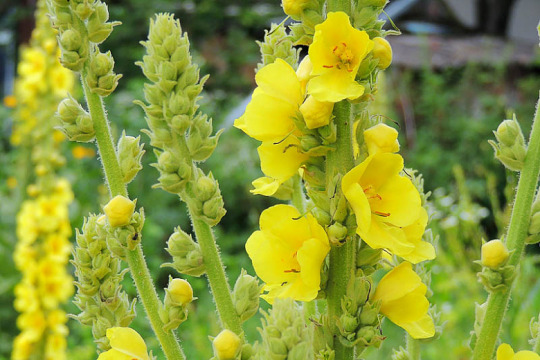
How to identify it: Mullein's defining features emerge in its second year, when it develops a tall, erect stem, growing up to 2 to 7 feet tall. It has soft leaves and yellow flowers.
Where to find it: Common mullein is found in neglected meadows and pasture lands, especially along fence roads, railroad tracks, in vacant lots, wood edges, forest openings, and industrial areas.
Edibility & flavor:
Benefits: Includes beneficial compounds such as saponins, flavonoids, phenylethanoid, iridoids, which are antioxidants, antibacterials, antivirals, and anti-inflammatories.
Caution: Skin contact with mullein can cause skin conditions, such as contact dermatitis.
Common Sheep Sorrel (Rumex acetosella)

How to identify it: Grows as a rosette of arrow-shaped leaves joined by a creeping root system. Every spring, its rosettes blossom into reddish upright flowers.
Where to find it: Located in open, disturbed areas, such as pastures, meadows, roadsides, and rights-of-way. Prefers gravelly and/or sandy soils and doesn't tolerate shade.
Edibility & flavor: The leaves and roots are edible raw or cooked. It has a slightly sour, tangy flavor due to its levels of oxalic acid.
Benefits: Historically used to treat inflammation, scurvy, diarrhea and, according to some limited research, heart issues and cancer. Contains antioxidants and nutrients like Vitamin C, fiber and magnesium.
Caution: Can cause kidney stones in large amounts, as well as damage to the kidneys, liver, and digestive organs.
Common Yarrow (Achillea millefolium)
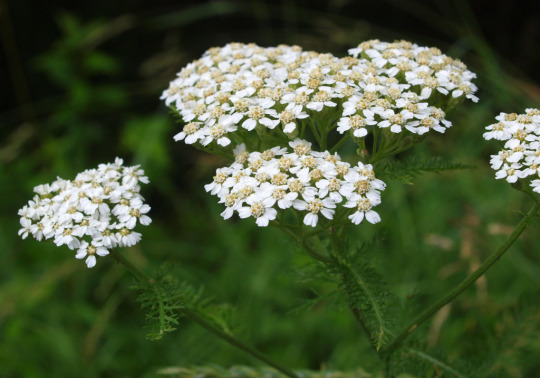
How to identify it: Wild Yarrow typically has white or, rarely, pink flowers; cultivated, it can have yellow, orange, pink or red flowers. The stems are grooved and have small, woolly hairs. Smells distinctly of pine needles.
Where to find it: Prefers sunny locations on thin, sandy soils, such as along roadsides or in fields, waste areas, canyon bottoms, subalpine zones, and even on lawns.
Edibility & flavor: Can be eaten raw or cooked, and has a somewhat bitter flavor.
Benefits: Treats digestive issues, such as ulcers and IBS, bloating, diarrhea, stomach pain, and constipation. Contains compounds that aid in digestion.
Caution: Can slow blood clotting, so avoid ingesting if you're bleeding or have a bleeding disorder. Yarrow can also cause an allergic reaction in people allergic to ragweed and other plants in the Asteraceae / Compositae family.
Dandelions (Taraxacum)

How to identify it: Both flowers in the above photo are dandelions. The white puffball upon which many people blow to scatter its seeds into the wind is what the yellow flowers mature into. These yellow flowers grow on single, unbranching, hollow stems and the leaves are lobed and produce a milky sap.
Where to find it: Dandelions can generally be found anywhere -- in lawns, gardens, parks, meadows, pastures, and disturbed areas. They prefer shade but they still thrive in hotter locations with direct sunlight.
Edibility & flavor: Both flower and stem are edible and can be eaten raw or cooked. The best time to harvest the leaves is when they're still young and tender, before they begin to flower.
Benefits: There are many health benefits of eating dandelions -- they're highly nutritious, contain potent antioxidants, are anti-inflammatories, aid in managing blood sugar, may reduce cholesterol and triglyceride levels, may lower blood pressure, may promote liver health, may aid in weight loss, may support healthy digestion and treat constipation, may boost immunity, may treat skin conditions, support health bones, and may have some cancer-fighting effects.
Caution: Dandelions can increase stomach acid and heartburn in some people, as well as cause skin irritation. People with kidney problems, gallbladder problems, and gallstones should check with their doctors before ingesting dandelions.
Field Chickweed (Stellaria media)
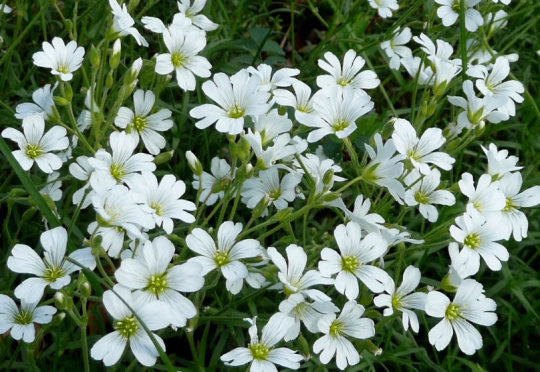
How to identify it: Chickweed is tender, stringy, and rarely grows more than a few inches off the ground. The leaves are small, grow opposite each other along the stem, and are small and teardrop- or egg-shaped with pointed tips.
Where to find it: Generally found in open, grassy areas and lawns.
Edibility & flavor: Chickweed can be eaten raw or cooked. It has a fresh, grassy flavor many compare to corn silk.
Benefits: Reduces inflammation, fights germs, promotes weight maintenance, and boosts immunity.
Caution: Though the potential for poisoning is low, large amounts of chickweed can cause diarrhea and vomiting.
#shtf plan#edible plants#edible flowers#f&d#food and drink#outdrs#foraging#gardening#prep#prepper#prepping#survival#survivalism#survivalist#off the grid#offgrid#acorns#burdock#catnip#chanterelle mushrooms#mullein#sheep sorrel#yarrow#dandelions#chickweed#part 1
98 notes
·
View notes